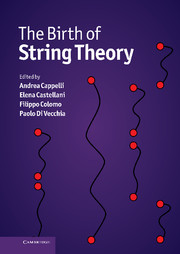Book contents
- Frontmatter
- Contents
- List of contributors
- Photographs of contributors
- Preface
- Abbreviations and acronyms
- Part I Overview
- EARLY STRING THEORY
- Part II The prehistory: the analytic S-matrix
- 5 Introduction to Part II
- 6 Particle theory in the Sixties: from current algebra to the Veneziano amplitude
- 7 The path to the Veneziano model
- 8 Two-component duality and strings
- 9 Note on the prehistory of string theory
- Part III The Dual Resonance Model
- Part IV The string
- TOWARDS MODERN STRING THEORY
- Part V Beyond the bosonic string
- Part VI The superstring
- Part VII Preparing the string renaissance
- Appendix A Theoretical tools of the Sixties
- Appendix B The Veneziano amplitude
- Appendix C From the string action to the Dual Resonance Model
- Appendix D World-sheet and target-space supersymmetry
- Appendix E The field theory limit
- Index
6 - Particle theory in the Sixties: from current algebra to the Veneziano amplitude
from Part II - The prehistory: the analytic S-matrix
Published online by Cambridge University Press: 05 May 2012
- Frontmatter
- Contents
- List of contributors
- Photographs of contributors
- Preface
- Abbreviations and acronyms
- Part I Overview
- EARLY STRING THEORY
- Part II The prehistory: the analytic S-matrix
- 5 Introduction to Part II
- 6 Particle theory in the Sixties: from current algebra to the Veneziano amplitude
- 7 The path to the Veneziano model
- 8 Two-component duality and strings
- 9 Note on the prehistory of string theory
- Part III The Dual Resonance Model
- Part IV The string
- TOWARDS MODERN STRING THEORY
- Part V Beyond the bosonic string
- Part VI The superstring
- Part VII Preparing the string renaissance
- Appendix A Theoretical tools of the Sixties
- Appendix B The Veneziano amplitude
- Appendix C From the string action to the Dual Resonance Model
- Appendix D World-sheet and target-space supersymmetry
- Appendix E The field theory limit
- Index
Summary
Introduction
During the Fifties it became clear that quantum electrodynamics (QED), constructed by applying the quantization rules to classical electrodynamics, was in very good agreement with experimental results. In particular, QED accounted for the deviations observed in experiments with respect to the Dirac theory of electrons and positrons. This was considered a major success of field theory.
In the following years, many efforts were made in the attempt to build a suitable theory for the description of the weak and strong interactions of elementary particles. These efforts culminated in the formulation of the electro-weak theory of Weinberg and Salam in 1967, and quantum chromodynamics in 1973. These are the two fundamental blocks of the Standard Model.
In the Sixties, when the theoretical community was still seeking a satisfying theory of strong interactions, several alternative approaches were explored, to overcome the encountered difficulties. In particular, one of these, the S-matrix, complemented with the bootstrap hypothesis and Dolen–Horn–Schmid duality, was to give rise to dual models and string theory.
The aim of the present Chapter is to recall some of the relevant results which originated in this context, in the years between 1961 and 1968, and which led to the Veneziano formula. In the next Section I will sketch the SU(3) symmetry and the quark model. In Section 6.3 I will recall current algebra, with a glance at its exploitation by means of sum rules.
- Type
- Chapter
- Information
- The Birth of String Theory , pp. 100 - 115Publisher: Cambridge University PressPrint publication year: 2012



